

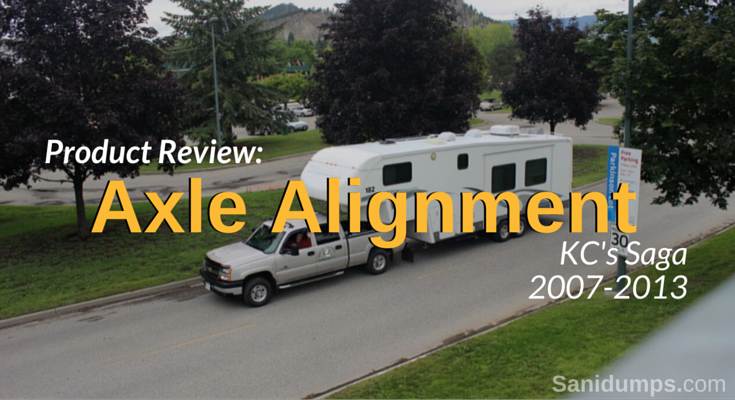
I have had four previous RVs, keeping each one for an average of 5 to 7 years, (two pop trailers and two travel trailers) and did not see a single issue with axles, unsafe trailering or abnormal tire wear. Therefore, I have never paid any particular attention to the undercarriage besides checking tire wear, repacking bearings and normal brake maintenance. I also never used my RV for more than 2 to 6 weeks per year, although I did make several long trips. Over a 20-year period, I had only replaced one set of tires.

Before I go into my axle saga, I do want to mention that RV frames, suspensions, axles, mountings and tires undergo tremendous forces both vertically (uneven roads and potholes) and horizontally (cornering and parking) as both wheels are fixed, unlike a motorized vehicle. These products are well-designed to withstand these tremendous forces when properly specified and installed. Unfortunately, some manufacturers install parts that meet minimum specs to save cost or select a subpar OEM supplier or misapply the parts as you will see in my case.
I purchased my current 35-foot 5th wheel in 2007 just after I retired. We spend anywhere between 6 and 18 weeks a year travelling and drive about 10-15,000 km per year. I soon started to see issues with my axles, wheels, tires and towing. Interestingly, the GVWR stated is 11,000 lb, with 5,000 lb dual axles and D-range tire (2840 lb). Keep in mind there is approximately 2,000 lb on the hitch pin. I was always feeling uneasy about the lack of safety margin. If there was any uneven loading side to side or front and back of the RV, one might easily exceed the axle rating or tire rating.

In 2008, Goodyear replaced all four tires due to excessive weathering and I took the opportunity to upgrade to E range tires (3000 lb). During the tire replacement process I noticed the nylon bushings on my Dexter axle linkages were wearing out. Then I started to see the linkage bolts wearing and the holes elongating, very similar to John's.
To correct this issue, I installed Dexter's E-Z Flex kit with bronze bushings with grease nipples, heavier yoke with rubber shock absorber and thicker linkages as shown:
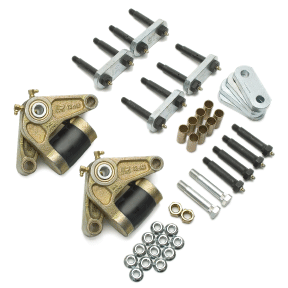
Ride Performance - This graph depicts the accelerations experienced by a trailer and axle while going over railroad tracks at 30 mph. The Dexter E-Z Flex equalizer provides an 80% reduction to trailer vertical acceleration when compared to a standard equalizer.
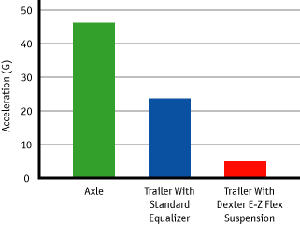
The net impact was a smoother ride, less chunking, virtually eliminating any movement of internal stuff in the RV and an increased peace of mind. The whole kit cost less than $300 and was very easy to install. I grease all the fittings at the start of every season.
In 2010, I received a notice from the manufacturer of the RV that they had issues with Dexter Nev-R-Lube axles burning the outside bearings. As it turned out the RV manufacturer had put -10 mm offset wheels when the axles clearly stated using zero offset wheels. Dexter volunteered a free replacement or an upgrade at cost. I seized the opportunity to upgrade my axles, u-bolts and Magnum gas shocks from 5,000 lb to 6,000 lb and to change the brakes from electric to hydraulic with an all disc system. After much research, I also opted to use EZ Lube axles instead of Nev-R-Lube. The additional cost was a little over $1,200 including all parts. I did the axle install and plumbing for the hydraulic system.







During this process I noticed that my original u-bolts were loose and upon further investigation, I found out that checking the torque on u-bolts is a maintenance item that no one talks about. Loose u-bolts could be a big safety issue. It is now on my annual maintenance checklist.
After installing the axles, I did do a measurement check to see if the axles were aligned using the method outlined in John's first report. Unfortunately, its accuracy is more like 1/4" rather than the required tolerance of less than 1/8".
I drove another 15-18,000 kms (approximate). During this time I had one tire blow out (front passenger side tire) which I replaced and I noticed my driver side front tire was wearing unevenly. I do rotate my tires at the start of each RV season to even out the wear which does make it difficult to diagnose problems.
I decided to replace all tires with Light Truck (LT) tires instead of ST trailer tires for 4 main reasons:
During my LT versus ST tire investigation, I was also advised by a local auto/truck/RV shop, that I should do a proper wheel alignment. It was worth paying approximate $200 to maximize the tire investment and be safe on the road. I took my RV in with brand new balanced tires installed and the experts did an accurate wheel alignment (camber, toe, caster and roll). For trailers, caster is not critical as it does not have powered wheels.

The laser equipment they use is highly accurate (see John's report for more details) and they give you a report on the measurement and the corrections they did.
After my first 800 km trip, I found that many items inside my RV had shifted while travelling (too much vibration and shock) which had previously not been an issue. Upon investigating, I found that I had too much air pressure (80 PSI) in my tires for the weight of my RV. Combined total weight the tires can handle at 80 PSI is 12,168 lb (+25% safety) but my RV loaded weighs less than 10,500 lb. Since you can adjust the tire pressure to the load (as per tire manufacturer's specifcations), I lowered my pressure to 72 PSI and the issue was resolved.
Since the tires are the only thing that keeps your RV on the road, road safety starts here. A little due diligence here can make your RVing experience problem free and safe for you and others around you. Here are some tips that I have learnt during the process:
Here are some consequences of problems RVers run into if proper maintenance is NOT done:

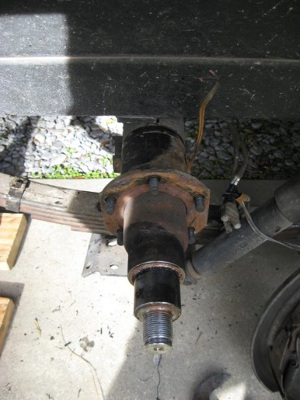
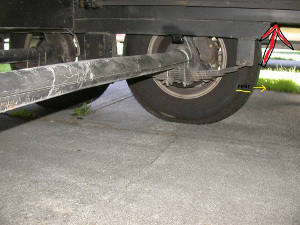


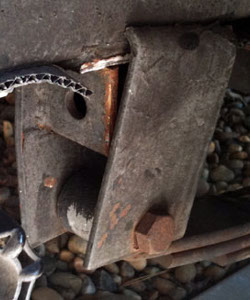
My trailer now tows smoothly with minimum chunking, excellent braking and minimum side to side rolling. I am expecting longer tread life for my tires and less stress during those long hot summer drives.
I highly recommend that RVers put the tires, suspension, linkages and axles in their normal maintenance schedule which includes a wheel alignment at least once and each time you feel you have hit something that could alter it.
Happy RVing,
KC
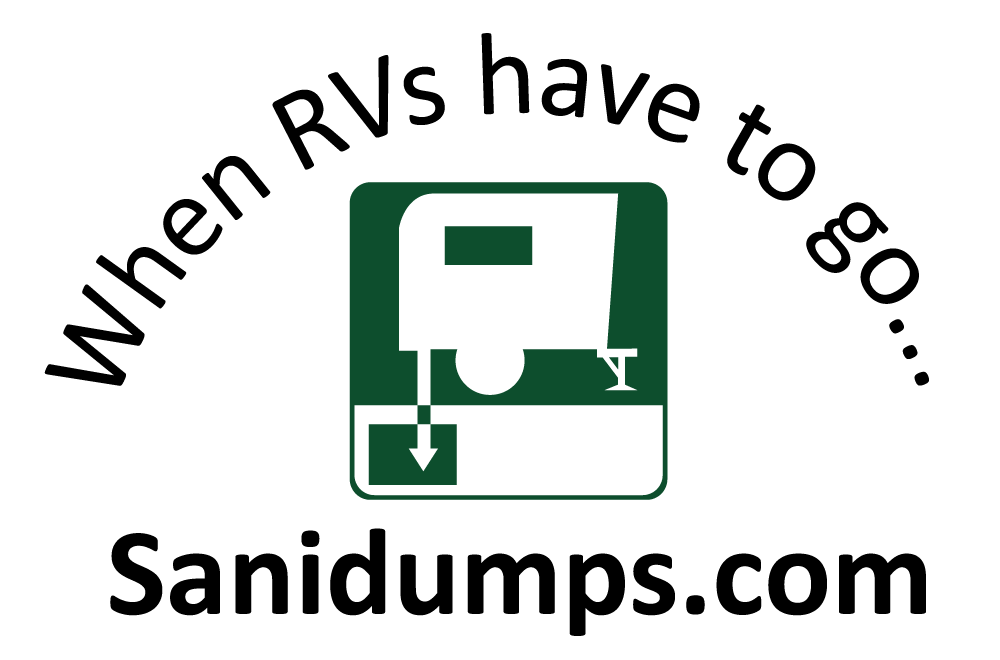
National Day Calendar
✔ Mark your calendar,
June 7 is
National RV Day,
Let's go RVing!
The type of recreational vehicle dump stations you will find on Sanidumps.com include: private, public, RV park, non-park, municipal, truck stop, rest stop, campground, camping, resort, commercial, pay, donation, waste disposal, and free.
It is important to dispose of human waste properly when RVing. The RV dump station, dump point, or sanidump station you choose to empty your gray and black water holding tanks is up to you; we're hoping that you will choose an approved dump station site that's green and environmentally friendly, using an environmentally sound method.
Do you need to know where to dump your holding tanks when your RV is on the road? Now you can know where the RV dump Stations are while traveling with a e-book. More information about the RV Dump Station location e-book.
Although efforts are made to make sure of the accuracy of the information presented, Sanidumps.com shall have neither liability nor responsibility to any person or entity with respect to any loss or damage caused, or alleged to be caused, directly or indirectly by the information contained here.
Sanidumps.com is not affiliated in any way with any place/location listed on this site. Fees are subject to change; availability and prices can and do change.
We thank all the RVers that have contributed information :-)
The Sanidumps.com Team
Serving the RV community for over 18 years
Sanidumps.com - When RVs have to go...™
© 2006 - 2024 Sanidumps.com - All rights reserved.
The content contained on this website may be used for personal reference only and may not be reproduced in any form without prior written consent permission from Sanidumps.com
Australia, Canada, Mexico, New Zealand, United States & more...